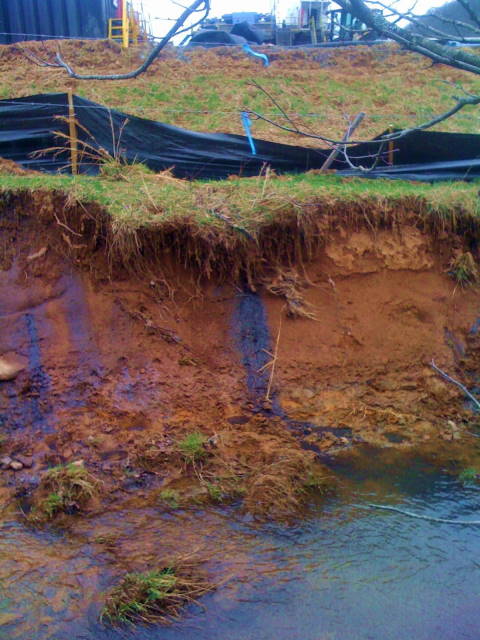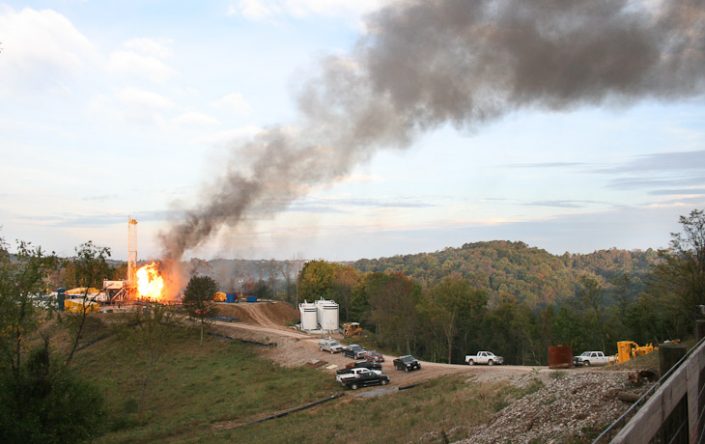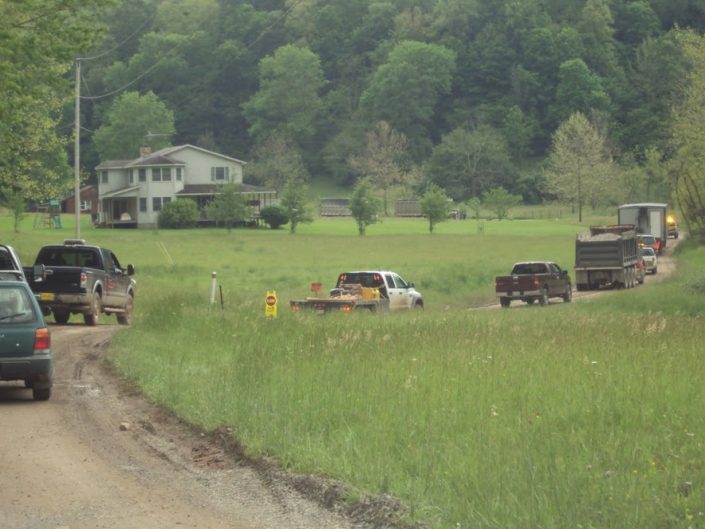The Right to a Healthy Home
Reframing Fracking in Our Communities
Imagine that tonight you head home to cook dinner. But, standing at your kitchen sink, you find that your tap water is suddenly running a funny color or gives off a bad smell. So instead of cooking, you order a pizza and decide to work outside in your garden. Just as you’re getting your hands dirty, however, you hear the roar of the compressor station that you see from your yard as its “blows off” some substance. Going back inside, and closing your windows to keep out the foul air, you think of the tap water and decide a shower is out of the question. Imagine that you resign yourself to just going to bed early – only to be kept awake by the bright and unnatural glow of gas being flared at the nearby wellhead.
Scenarios just like these can and do happen when hydraulic fracturing, or fracking, encroaches upon residential areas.
In Part 1 of this two-part series, we described how the many aspects of fracking can destroy a healthy home environment and argued for a frame that focuses on those impacts. A frame is a way of contextualizing, communicating about, and understanding an issue.
This article brings in the idea of rights, and lists several declared rights that fracking violates. Returning to the topic of framing, we then challenge the fracking-friendly frame, by calling into question three common ways of talking about fracking that ignore the rights of those impacted.
In short, the push to support fracking often ignores the rights of people living near it.
Healthy Homes for Human Flourishing
First, let’s explore why a having healthy home matters.
Everyone has a basic need for a safe, healthy place to live. The World Health Organization identifies the social determinants of health (SDH) as the “conditions in which people are born, grow, work, live, and age, and the wider set of forces and systems shaping the conditions of daily life.” Applied to healthy homes, these SDH include access to clean air and safe drinking water, and protection from intrusion and disaster. Health is not merely the absence of disease. Health can mean the ability to function, to live one’s life,[1] to flourish.
Human flourishing demands a healthy home environment. Picture again the scenario at the beginning of this article. Would you be able to care for yourself and your family members, to meet your basic needs, or to lead a satisfying life if your home didn’t seem like a safe place to live?
Using Rights to Make the Case
Many people who live near drilling often ask themselves that very question. These include people like Pam Judy, with a compressor station less than 800 feet from her house, who questions the long term effects of breathing in the 16 chemicals detected in air test conducted by the PA Department of Environmental Protection.
Greene County, PA resident Pam Judy and the compressor station near her home in Gas Rush Stories, part 5: A Neighbor from Kirsi Jansa on Vimeo.
Simply reading or watching the stories of those directly impacted by gas development makes a moving argument for the right to a healthy home environment – and that argument also has a lot of backing. Researchers[2] have made a powerful case that fracking can and has violated human rights, by impacting the health for those downwind or downstream and by denying civil liberties to those pushed aside or silenced during the debate. These same researchers showed specifically that fracking has violated the rights to privacy, family, home, and protection of property.
Various governments and non-governmental organizations around the world have likewise called out human rights violations due to fracking. Other human rights declarations are relevant here, too. Fracking’s impacts are incompatible with the rights to health and to housing. Here’s a sampling:
This sampling of precedents includes statements and declarations by the United Nations and the Organization of American States. It shows that when it comes to human rights and fracking, a strong case has already been made by respected international organizations.
Challenging the fracking-friendly frame
A rights-based perspective, informed by precedents like those above, gives us a strong platform from which to examine and counter arguments that support or promote fracking. We can call those pro-fracking arguments a “fracking-friendly” frame.
A fracking-friendly frame denies or minimizes the human impacts. We can hear elements of the fracking-friendly frame underlying industry promises and political talking points, and witness how they leach into common dialogue between citizens.
Element #1: “Economic impacts”- but only the positives
An “economic impacts ” emphasis tends to focus on narrowly-defined economic benefits , while excluding other real, negative economic drawbacks , like the latter half of boom & bust cycles. Consider this infographic of the “economic impacts” of an Appalachian petrochemical hub scenario–an industry reliant upon the cheap and abundant fracked natural gas of the region. The document offers projected estimates for industry profits and employment levels potentially generated by the five ethane crackers planned for the region. But this document – and its focus on economics – says nothing about the negative consequences to the community. Due to air emissions from these facilities, health costs from fine particulate matter (PM 2.5) could amount to between $120 and $270 million each year, without even factoring in the additional impacts of ozone or toxics. A focus on economic impacts also says nothing about the incalculable value of lives – and quality of life – lost, which could amount to between 14 and 32 additional deaths annually, plus increased asthma, heart attacks, and bronchitis.[3]
Element #2: “Choice”
A false assumption of choice is built into the fracking-friendly frame. This element assumes that people have a choice–if they don’t like the drilling next door, they can just move. Yet, as well water becomes degraded and countryside views become dominated by unprecedented industrial development, selling a home can be a difficult proposition. As one researcher summed it up,
the various forms of land damage from fracking often result in decreased property values, making resale and farming difficult , and also making it harder to acquire mortgages and insurance. Properties adjoining drilling sites are often simply unsellable, as no one wants to live with the noise, the bad air, and the possibility of water pollution.[4]
Others confirm this fallout to home values. A recent report assessing 16 other studies on how UOGD affects home prices points to significant potential decreases in housing values for those on well water (up to -$33,000) and those without ownership of their mineral rights (up to -$60,000). These unfortunate realities belie the idea of choice.
On left, a white fracking rig at the far left of the image sits near a cabin overlooking the town of McDonald, PA. On right, a pipeline cut descends a hillside and into a residential development outside of Houston, PA. Photo credit: Leann Leiter.
In interviews conducted with women living in close quarters to drilling activity, three health care professionals[5] discovered the sense of powerlessness experienced they felt. One woman contemplated moving away from the region in spite of opposition from her husband and her own attachment to her home. In my own interaction with affected families, many express powerful feelings about relocation like sadness about leaving land owned for generations, or an eagerness to escape a home that no longer feels safe. Many express a sense of injustice for being forced to make such painful choices.
Element #3: “Sacrifice of the few for the good of the many”
Another underlying assumption of a fracking-friendly frame is that of “sacrifice of the few for the good of the many.” It declares that a “few” people will have to live near fracking and bear the unfortunate consequences, so many others can have cheap oil and gas. The belief bubbles up among the public, such as in this comment collected during a survey[6] of people living in the Marcellus shale gas region:
Energy has to come from somewhere. The needs of the many may outweigh the inconvenience of the few who live near the exploration efforts. This is not an ideal situation for all residents, but it is the reality.
This person’s statement shows acceptance of the assumption that energy for all requires unevenly shared sacrifice, and indicates a drastic underestimation of the populations impacted. It also indicates a misperception of the impacts, which unfortunately go far beyond mere “inconvenience” for many residents.
We can break down these assumptions by questioning how many people make sacrifices in the name of gas extraction. An interactive map by FracTracker shows that over 12 million Americans live within a risky ½ mile of oil and gas facilities (including both fracking wells and other types). Mounting research indicates health threats for distances of ½ mile or greater. That meaning this ever-growing number of Americans have increased rates of asthma and prenatal harms, with the most vulnerable – the young, the elderly, and those with pre-existing conditions – at the highest risk. The 12 million figure, already a conservative estimate, would be significantly higher if factoring in other oil and gas infrastructure like pipelines or frac sand mining operations, each of which carry their own risks.
Populations in US near activity oil and gas drilling activity in 2016. Click to explore the interactive map.
We can also question the nature of their sacrifice. In terms of health, research has shown correlations between how close women live to fracking operations and certain birth defects and noise-induced sleep disturbance and cardiovascular disease, as just a few examples. Facilities like well pads also come with risks to public safety, such as the Monroe County, Ohio well pad fire that burned unknown chemicals for five days near homes and resulted in 70,000 fish killed in a creek that flows to the Ohio River. Other fracking infrastructure likewise poses potential dangers from the 2.5 million miles of gas pipeline and additional 200,000 for hazardous liquids including crude oil that crisscross the United States. Between 2010 and 2016 the US experienced 230 reported pipeline explosions, 635 fires, over 20,000 people evacuated, 470 injured, and 100 lives lost.
The view of nearby homes from a pipeline right-of-way, along with list of emergency contacts in case of incident. Safety precautions like these remind us of the potentially injurious nature of gas infrastructure. They also highlight the level of sacrifice being demanded of households near the hazard. Photo credit: Leann Leiter.
Building social support
These elements of a fracking-friendly frame function to isolate those who are experiencing negative effects in their own homes by minimizing, even denying, the impacts they are experiencing. Researchers in extractive regions have observed the power of this isolation. In some rural areas, isolation may be supported in part by cultural norms, such as an Appalachian appreciation for “minding one’s own business.” In at least one fracking-affected community, this widely-accepted norm hampers sharing among neighbors, prompting one resident’s complaint that “we’re all fighting like individuals.”[7] In a study of a community being driven from their homes by coal mining and power generation, another set of extractive, industrial activities, one participant lamented:
I think one of the problems of the mining and the industry is, they play on the basic everyday person’s lack of resources. There’s no social support for displacement, none whatsoever.[8]
A healthy homes frame, focused on universally shared human rights, powerfully counters the isolation. It reminds those who are suffering or have concerns about the changes to their home environment that they are not alone; others around the world are experiencing similar impacts to their households. Adopting this frame for understanding fracking is a show of support, one that acknowledges their plight.
Nearly everyone values and desires a healthy home, regardless of whether that home is an apartment, a nursing home, a cabin, or a mobile home. This frame extends beyond geographical, economical, and cultural barriers. It encourages social support from those currently removed from shale plays and the hydraulic fracturing used in extracting their resources. It empowers action, with the home front as a site of resistance, by articulating the range of rights being violated.
Focusing on what we’re fighting for
Re-centering the problems of fracking as they impact the right to a healthy home makes sense to those of us witnessing the degradation of the places people need in order to live and flourish. A rights-based approach focuses on what we’re fighting for, rather than giving extra airtime to the already-powerful frame we must fight against.
- If you need assistance protecting your rights from planned fracking, the Delaware Riverkeeper Network offers a guide for communities and their local leaders to defending environmental rights at the municipal level.
- For those already impacted, Fair Shake Environmental Legal Services provides “sliding scale” legal help to people in the Appalachian basin.
- For communities at any stage of gas development, Environmental Health Project has created a Where to Turn for Help directory full of sources for air testing services, community organizing, health information, tracking and reporting fracking development and violations, and much more.
Whether or not you feel the direct impacts of fracking, we are all connected to this extensive process. Fracking’s commodity products – energy and plastics – are part of all of our lives; it’s climate-altering effect diminishes all of our futures. More importantly, we all have a crucial role to play. Here is how you can get further involved:
- Communicate with your lawmakers – share with them this article series or your own take on fracking, and ask what frame they are using when they make decisions on this and other dangerous modes of energy extraction.
- Join Halt the Harm Network to get connected to people, groups and events “working to fight the harms of oil and gas development.”
- Follow @EnvironmentalHealthProject on Facebook and @EHPinfo on Twitter, and participate in the evolving discussion!
Bringing rights into the conversation on fracking challenges the fracking-friendly frame, and promotes instead protection for those in fracked households.
Special thanks to the many individuals and families who shared the experiences that informed this article series.
References:
- Resick, L. K., Knestrick, J. M., Counts, M. M., & Pizzuto, L. K. (2013). The meaning of health among mid-Appalachian women within the context of the environment. Journal of Environmental Studies and Sciences , 3 (3), 290-296.
- Short, D., Elliot, J., Norder, K., Lloyd-Davies, E., & Morley, J. (2015). Extreme energy, ‘fracking’ and human rights: a new field for human rights impact assessments? , The International Journal of Human Rights, 19:6, 697-736, DOI:10.1080/13642987.2015.1019219
- John Graham, Senior Scientist at Clean Air Task Force, personal communication, June 9, 2017. Health impacts modeling completed using EPA Co-Benefits and Risk Assessment (COBRA) Screening Tool, using estimated PM 2.5 air emissions for permitted Shell ethane cracker in Beaver County, PA and four additional facilities planned in Ohio and West Virginia.
- Richard Heinberg cited in Short, D., Elliot, J., Norder, K., Lloyd-Davies, E., & Morley, J. (2015). Extreme energy, ‘fracking’ and human rights: a new field for human rights impact assessments? , The International Journal of Human Rights, 19:6, 697-736, DOI:10.1080/13642987.2015.1019219
- Resick, L. K., Knestrick, J. M., Counts, M. M., & Pizzuto, L. K. (2013). The meaning of health among mid-Appalachian women within the context of the environment. Journal of Environmental Studies and Sciences , 3 (3), 290-296.
- Cooley, R., & Casagrande, D. (2017). Marcellus Shale as Golden Goose. ExtrACTION: Impacts, Engagements, and Alternative Futures. Routledge.
- Resick, L. K., Knestrick, J. M., Counts, M. M., & Pizzuto, L. K. (2013). The meaning of health among mid-Appalachian women within the context of the environment. Journal of Environmental Studies and Sciences , 3 (3), 290-296.
- Connor et al., p. 54. Linda Connor, Glenn Albrecht, Nick Higginbotham, Sonia Freeman, and Wayne Smith. (2004). Environmental Change and Human Health in Upper Hunter Communities of New South Wales, Australia. EcoHealth 1 (Suppl.2), ,47-58. DOI: 10.1007/s10393-004-0053-2
By Leann Leiter, Fellow with the Environmental Health Project and FracTracker Alliance


